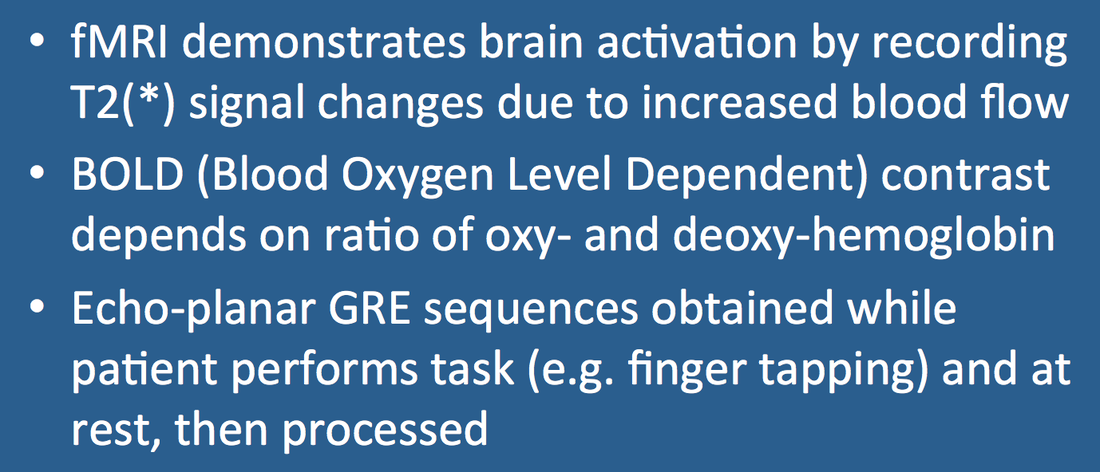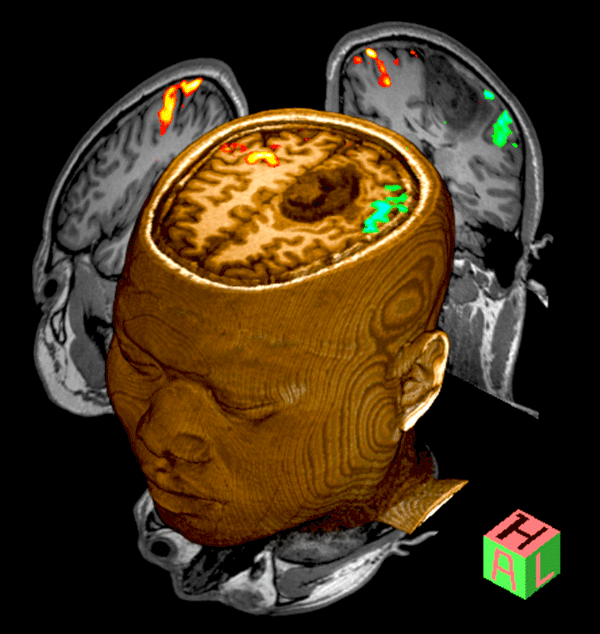|
Although it may have many uses, the term functional MRI (fMRI) generally refers to the imaging of brain activation detectable by changes in regional cerebral blood flow. Increased blood flow alters the local ratio of (paramagnetic) deoxyhemoglobin to (diamagnetic) oxyhemoglobin, thus affecting T2 and T2*. Signal intensity variations in the MR image result from this so-called BOLD (Blood Oxygen Level Dependent) contrast.
In a typical clinical BOLD-fMRI experiment, the subject is asked to intermittently perform various tasks (such as finger tapping or silent word generation) while lying in the scanner. Echo-planar gradient echo whole brain images are obtained during the task and at rest. A statistical comparison between task and rest (plus additional processing) allows generation of activation maps that can be overlaid on anatomic images. |
This is a brief introduction to the BOLD-fMRI technique only. More detailed descriptions of each step are available in subsequent Q&A's.
|
|
Good introductory video for most aspects of fMRI
|
It should be noted that a relatively new and increasingly popular fMRI method, resting state (RS)- fMRI, does not utilize specific tasks such as finger tapping. Instead the patient simply lies in the scanner and spontaneous BOLD signal fluctuations reflecting brain activity are recorded and analyzed. The details of RS-fMRI are described in several Q&A's in the advanced tab (Functional MRI/BOLD-II). The remainder of this tab (Functional MRI/BOLD-I) will be focused on task (stimulus)-based fMRI.
|
Advanced Discussion (show/hide)»
No supplementary material yet. Check back soon!
References
Barkhof F, Haller S, Rombouts SARB. Resting-state functional MR imaging: a new window to the brain. Radiology 2014; 272:29-49.
Brown GG, Perthen JE, Liu TT, Buxton RB. A primer on functional magnetic resonance imaging. Neuorpsychol Rev 2007; 17:107-125.
Chen JE, Glover GH. Functional magnetic imaging methods. Neuropsychol Rev 2015; 25:289-313.
Lindquist MA, Wager TD. Principles of fMRI. Leanpub, 2015. (Excellent and inexpensive recent textbook, available for download only.)
Barkhof F, Haller S, Rombouts SARB. Resting-state functional MR imaging: a new window to the brain. Radiology 2014; 272:29-49.
Brown GG, Perthen JE, Liu TT, Buxton RB. A primer on functional magnetic resonance imaging. Neuorpsychol Rev 2007; 17:107-125.
Chen JE, Glover GH. Functional magnetic imaging methods. Neuropsychol Rev 2015; 25:289-313.
Lindquist MA, Wager TD. Principles of fMRI. Leanpub, 2015. (Excellent and inexpensive recent textbook, available for download only.)
Related Questions
Who invented functional MR imaging (fMRI)?
How is image contrast produced by BOLD?
What is the best pulse sequence to use for BOLD fMRI?
Who invented functional MR imaging (fMRI)?
How is image contrast produced by BOLD?
What is the best pulse sequence to use for BOLD fMRI?

